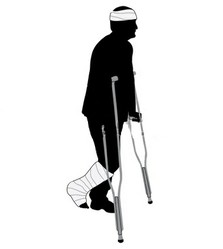Lower body injuries can be much more serious in that they have much more significant impact on your daily routine. It is quite likely that you are not able to walk, especially at first. You will be blown away by how limited you suddenly become when you can't walk. Performing simple tasks in your home require calculations in order to most economically do as much as possible with the least movement involved. Often, you'll require limb elevation for a period of time. Showering and going to the bathroom become major events, especially if you live alone. Once things begin healing enough so that you can start getting around a little, you'll still have many limitations.
Depending on the severity of your injury, you may be 'laid up' for a rather long time. Muscles atrophy in the areas you aren't using. You lose flexibility in the muscles, tendons and ligaments. Your cardiovascular health will deteriorate. But it needn't be quite as horrible as it all sounds. As you begin to heal, there are things you can do to exercise. You may not be able to run, walk quickly, or climb stairs, but you can do limited yoga, pilates, mat work, and dance. Yes, you heard me correctly - dance. Not John Travolta-style dancing, but if you're arms are working, and you're gaining stability in your affected limb, you can get some cardiovascular activity going that will also benefit your balance and proprioception.
As with all injury recovery, you'll likely want to speak with a health professional prior to starting an exercise program, but overcome any nervousness about testing out an unreliable limb. Regaining strength is important.











 Writing Posthumouslyon 05/08/2013
Writing Posthumouslyon 05/08/2013
 God or The Queen: Your Choiceon 05/04/2013
God or The Queen: Your Choiceon 05/04/2013
 Broken Ankle Boogieon 05/02/2013
Broken Ankle Boogieon 05/02/2013
 Toulouse-Lautrec: Approaching Humanity with Different Brush Strokeson 05/01/2013
Toulouse-Lautrec: Approaching Humanity with Different Brush Strokeson 05/01/2013



Comments
Yes!!!! Absolutely. I've heard of it, and it is a fantastic idea of you're not at the point where you can stand up to boogie. Thanks for reminding me!
I'll let you in on a great fitness program I found a couple of years back that would be great for people with foot/leg injuries. It's called Chair Dancing. A complete fitness program done from the seat of a chair! You can probably find the Dvds on Amazon. They might be something good to offer here...